The show site for the excavation and restoration work in the so-called Keeper’ s Room of the Augustal Seat has been launched at the Herculaneum Archaeological Park. This project includes documentation, excavation, maintenance and restoration activities, with the intention of highlighting the importance of ministerial initiatives in the context of Art Bonus.
In 1961, Amedeo Maiuri made an extraordinary discovery here: he found a charred wooden bed on which lay the skeleton of a man in his early twenties, a victim of the 79 AD eruption that devastated Herculaneum. At the time, the discovery of skeletons of victims of the eruption was rare (it was not until the 1980s that 340 skeletons were discovered on the ancient beach), and this discovery was particularly significant. The bed, with its tragic cargo of information about the city’s last moments, was displayed in a shrine at the exact site of the discovery. However, over the following decades, the display and preservation conditions deteriorated to the point that it was necessary to close this environment, located in one of the most visited buildings of the archaeological site, to the public.
In recent years, the Herculaneum Archaeological Park team has resumed studies and research on this find, collaborating with professionals from theHerculaneum Conservation Project. In this context, an initial investigation of the skeletal remains, conducted by a team led by Pier Paolo Petrone of the Federico II University of Naples, identified crystallized remains in the vicinity of the keeper’s head that scholars from the Frederican team believe to be brain tissue.
Currently, the Park has launched an ambitious project that includes the study, conservation, restoration and enhancement of theentire Keeper’s Room. The goal is to deepen our understanding of this context and to rearrange the room so that it becomes accessible to visitors.
The Archaeological Park team, in collaboration with archaeologists from the Herculaneum Conservation Project, has developed a multidisciplinary intervention that also involves the universities of Bordeaux and Limoges, with the participation of Henry Duday, Director Emeritus of Research at CNRS. The excavation will follow extremely high standards of documentation, allowing the possibility of 3D-printing the skeletal remains. At the conclusion of the campaign to restore and secure the structures and decorative apparatus, the skeletal remains will be relocated to their original position.
All visitors will be able to watch the site activities and see the work of archaeologists and restorers live on a screen visible from outside the Keeper’s Room. The project presented on the Ministry of Culture’s Art bonus portal was supported by a substantial donation from a member of the Friends of Herculaneum Society of Cambridge and co-funded by the Ministry of Culture.
“This project is particularly close to my heart,” said director Francesco Sirano, “for many reasons: the exceptional nature of the find and the scientific perspectives opened up by the crystallized remains present at the victim’s head, the archaeological context where the find took place, which is one of the most important public buildings of ancient Herculaneum, and the extraordinary convergence of an international, public and private project. I would like to remember here Peter Smith, who unfortunately recently passed away. I like to think that Peter, who had come to Herculaneum several times and with whom we had discussed and shared so many points of the initiative, had approached the archaeological site inspired by the great and visionary example of David Packard, who with the Packard Humanities Institute for 22 years has been fielding in Herculaneum an activity of strengthening, programming and capacity building for management over the short and long term recognized as a best practice worldwide. But this occasion also confirms the validity of ministerial initiatives, such as the Art Bonus, aimed at liberal donations by all citizens who can become, according to the availability of each, patrons of art and culture.”
Investigated as early as Bourbon times in the spring of 1740, the Seat of the Augustals was completely cleared of the pyroclastic deposit in the long season of open excavation undertaken by Amedeo Maiuri beginning in 1927. In 1961 the skeleton of a man in his early twenties, presumably the building’s janitor, was discovered buried under volcanic mud on a wooden bed. The excavation of the bed remained voluntarily unfinished to allow the public an immersive visitor perspective, in adherence to Maiuri’s idea of a Museum City with the possibility of handing down further discoveries to posterity, with the far-sighted vision of progress in archaeology.
The project also includes major maintenance work on the structural and decorative elements of the room. To facilitate this work, a field laboratory will be set up inside the Augustal Seat, allowing the interdisciplinary team to collaborate and engage visitors in the recovery process without compromising the immersive experience in the striking environment decorated with frescoes.
 |
| Herculaneum, show site started in the Custodian's Room of the Augustal Seat |
Warning: the translation into English of the original Italian article was created using automatic tools. We undertake to review all articles, but we do not guarantee the total absence of inaccuracies in the translation due to the program. You can find the original by clicking on the ITA button. If you find any mistake,please contact us.